CADILLAC LYRIC 2023 Owners Manual
Manufacturer: CADILLAC, Model Year: 2023, Model line: LYRIC, Model: CADILLAC LYRIC 2023Pages: 424, PDF Size: 4.76 MB
Page 301 of 424
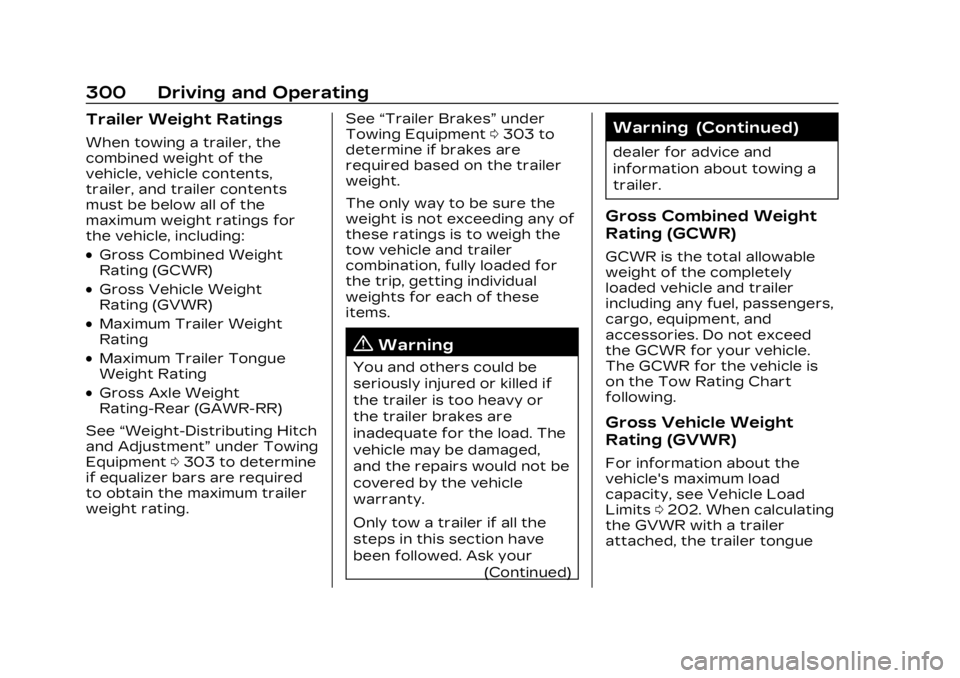
Cadillac Lyriq Owner Manual (GMNA-Localizing-U.S./Canada-15644413) -
2023 - CRC - 2/23/22
300 Driving and Operating
Trailer Weight Ratings
When towing a trailer, the
combined weight of the
vehicle, vehicle contents,
trailer, and trailer contents
must be below all of the
maximum weight ratings for
the vehicle, including:
.Gross Combined Weight
Rating (GCWR)
.Gross Vehicle Weight
Rating (GVWR)
.Maximum Trailer Weight
Rating
.Maximum Trailer Tongue
Weight Rating
.Gross Axle Weight
Rating-Rear (GAWR-RR)
See “Weight-Distributing Hitch
and Adjustment” under Towing
Equipment 0303 to determine
if equalizer bars are required
to obtain the maximum trailer
weight rating. See
“Trailer Brakes” under
Towing Equipment 0303 to
determine if brakes are
required based on the trailer
weight.
The only way to be sure the
weight is not exceeding any of
these ratings is to weigh the
tow vehicle and trailer
combination, fully loaded for
the trip, getting individual
weights for each of these
items.
{Warning
You and others could be
seriously injured or killed if
the trailer is too heavy or
the trailer brakes are
inadequate for the load. The
vehicle may be damaged,
and the repairs would not be
covered by the vehicle
warranty.
Only tow a trailer if all the
steps in this section have
been followed. Ask your
(Continued)
Warning (Continued)
dealer for advice and
information about towing a
trailer.
Gross Combined Weight
Rating (GCWR)
GCWR is the total allowable
weight of the completely
loaded vehicle and trailer
including any fuel, passengers,
cargo, equipment, and
accessories. Do not exceed
the GCWR for your vehicle.
The GCWR for the vehicle is
on the Tow Rating Chart
following.
Gross Vehicle Weight
Rating (GVWR)
For information about the
vehicle's maximum load
capacity, see Vehicle Load
Limits0202. When calculating
the GVWR with a trailer
attached, the trailer tongue
Page 302 of 424
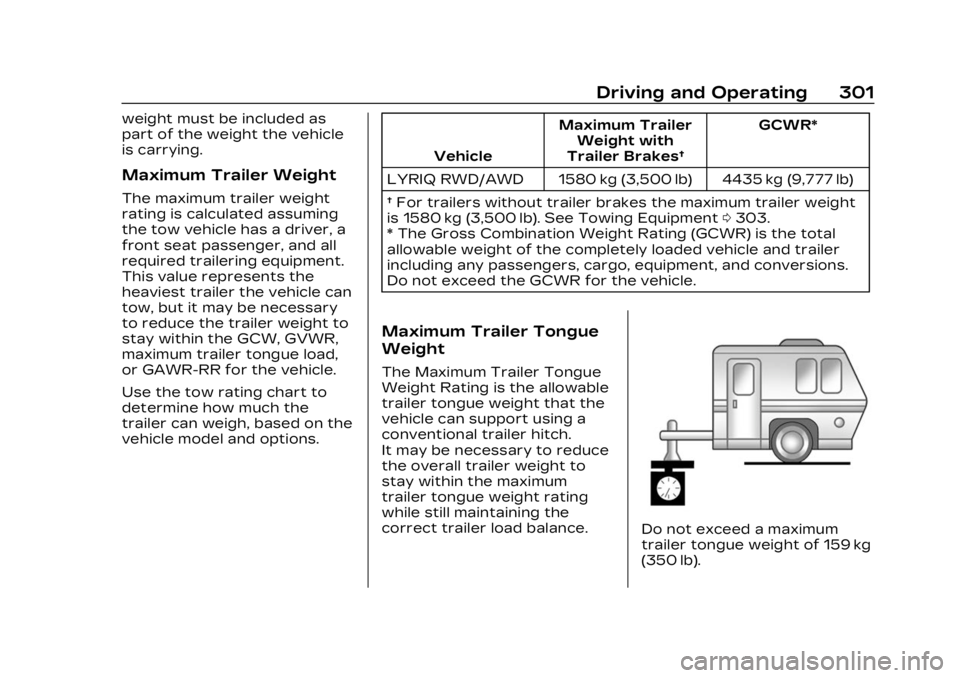
Cadillac Lyriq Owner Manual (GMNA-Localizing-U.S./Canada-15644413) -
2023 - CRC - 2/23/22
Driving and Operating 301
weight must be included as
part of the weight the vehicle
is carrying.
Maximum Trailer Weight
The maximum trailer weight
rating is calculated assuming
the tow vehicle has a driver, a
front seat passenger, and all
required trailering equipment.
This value represents the
heaviest trailer the vehicle can
tow, but it may be necessary
to reduce the trailer weight to
stay within the GCW, GVWR,
maximum trailer tongue load,
or GAWR-RR for the vehicle.
Use the tow rating chart to
determine how much the
trailer can weigh, based on the
vehicle model and options.Vehicle
Maximum Trailer
Weight with
Trailer Brakes† GCWR*
LYRIQ RWD/AWD 1580 kg (3,500 lb) 4435 kg (9,777 lb)
† For trailers without trailer brakes the maximum trailer weight
is 1580 kg (3,500 lb). See Towing Equipment 0303.
* The Gross Combination Weight Rating (GCWR) is the total
allowable weight of the completely loaded vehicle and trailer
including any passengers, cargo, equipment, and conversions.
Do not exceed the GCWR for the vehicle.
Maximum Trailer Tongue
Weight
The Maximum Trailer Tongue
Weight Rating is the allowable
trailer tongue weight that the
vehicle can support using a
conventional trailer hitch.
It may be necessary to reduce
the overall trailer weight to
stay within the maximum
trailer tongue weight rating
while still maintaining the
correct trailer load balance.
Do not exceed a maximum
trailer tongue weight of 159 kg
(350 lb).
Page 303 of 424
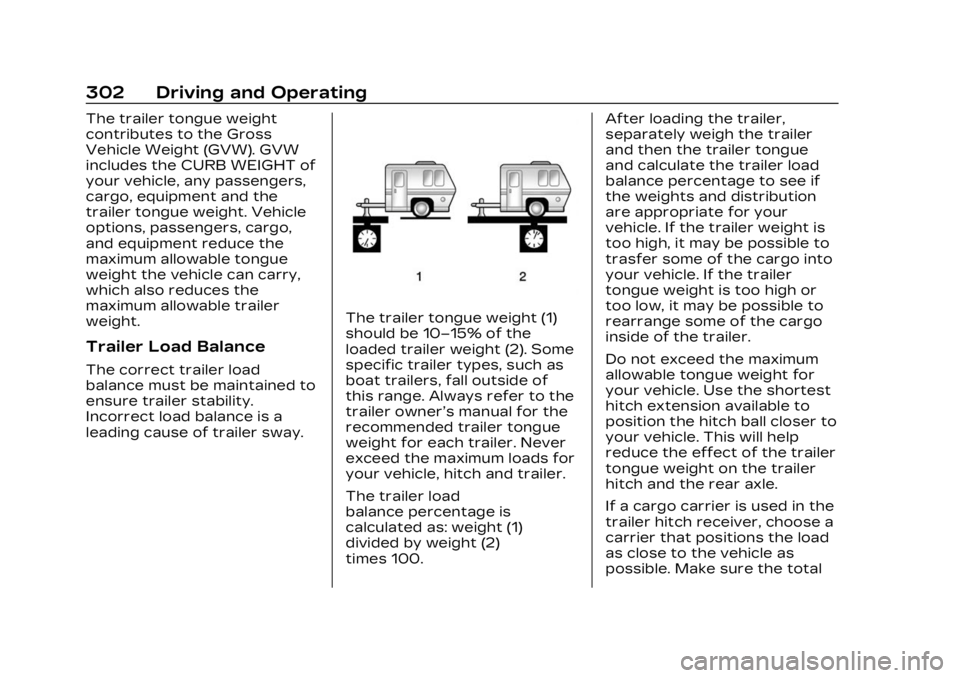
Cadillac Lyriq Owner Manual (GMNA-Localizing-U.S./Canada-15644413) -
2023 - CRC - 2/23/22
302 Driving and Operating
The trailer tongue weight
contributes to the Gross
Vehicle Weight (GVW). GVW
includes the CURB WEIGHT of
your vehicle, any passengers,
cargo, equipment and the
trailer tongue weight. Vehicle
options, passengers, cargo,
and equipment reduce the
maximum allowable tongue
weight the vehicle can carry,
which also reduces the
maximum allowable trailer
weight.
Trailer Load Balance
The correct trailer load
balance must be maintained to
ensure trailer stability.
Incorrect load balance is a
leading cause of trailer sway.
The trailer tongue weight (1)
should be 10–15% of the
loaded trailer weight (2). Some
specific trailer types, such as
boat trailers, fall outside of
this range. Always refer to the
trailer owner’s manual for the
recommended trailer tongue
weight for each trailer. Never
exceed the maximum loads for
your vehicle, hitch and trailer.
The trailer load
balance percentage is
calculated as: weight (1)
divided by weight (2)
times 100.After loading the trailer,
separately weigh the trailer
and then the trailer tongue
and calculate the trailer load
balance percentage to see if
the weights and distribution
are appropriate for your
vehicle. If the trailer weight is
too high, it may be possible to
trasfer some of the cargo into
your vehicle. If the trailer
tongue weight is too high or
too low, it may be possible to
rearrange some of the cargo
inside of the trailer.
Do not exceed the maximum
allowable tongue weight for
your vehicle. Use the shortest
hitch extension available to
position the hitch ball closer to
your vehicle. This will help
reduce the effect of the trailer
tongue weight on the trailer
hitch and the rear axle.
If a cargo carrier is used in the
trailer hitch receiver, choose a
carrier that positions the load
as close to the vehicle as
possible. Make sure the total
Page 304 of 424
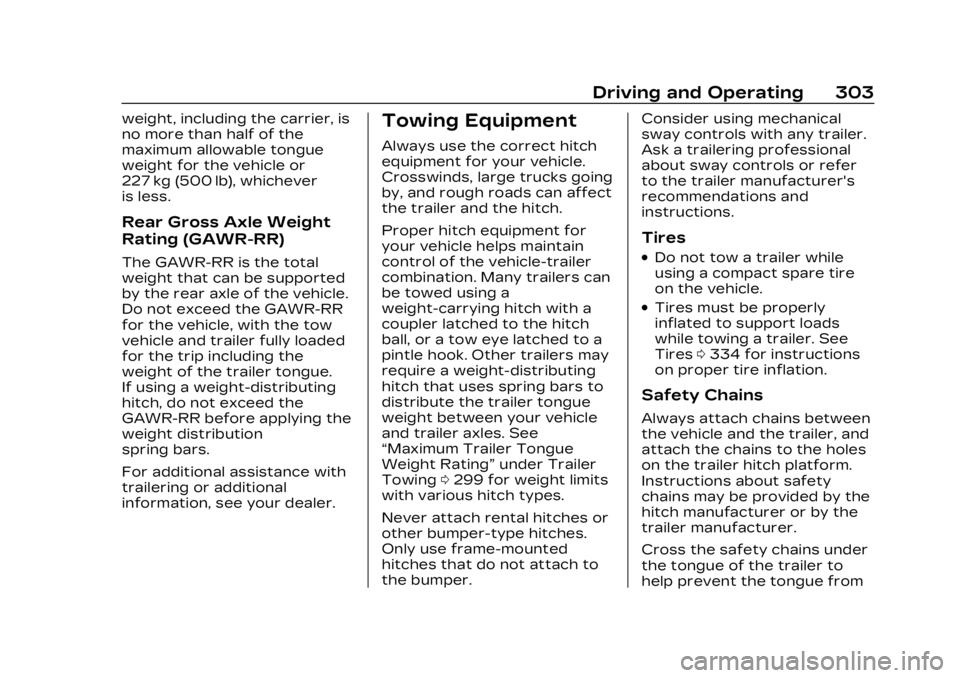
Cadillac Lyriq Owner Manual (GMNA-Localizing-U.S./Canada-15644413) -
2023 - CRC - 2/23/22
Driving and Operating 303
weight, including the carrier, is
no more than half of the
maximum allowable tongue
weight for the vehicle or
227 kg (500 lb), whichever
is less.
Rear Gross Axle Weight
Rating (GAWR-RR)
The GAWR-RR is the total
weight that can be supported
by the rear axle of the vehicle.
Do not exceed the GAWR-RR
for the vehicle, with the tow
vehicle and trailer fully loaded
for the trip including the
weight of the trailer tongue.
If using a weight-distributing
hitch, do not exceed the
GAWR-RR before applying the
weight distribution
spring bars.
For additional assistance with
trailering or additional
information, see your dealer.
Towing Equipment
Always use the correct hitch
equipment for your vehicle.
Crosswinds, large trucks going
by, and rough roads can affect
the trailer and the hitch.
Proper hitch equipment for
your vehicle helps maintain
control of the vehicle-trailer
combination. Many trailers can
be towed using a
weight-carrying hitch with a
coupler latched to the hitch
ball, or a tow eye latched to a
pintle hook. Other trailers may
require a weight-distributing
hitch that uses spring bars to
distribute the trailer tongue
weight between your vehicle
and trailer axles. See
“Maximum Trailer Tongue
Weight Rating”under Trailer
Towing 0299 for weight limits
with various hitch types.
Never attach rental hitches or
other bumper-type hitches.
Only use frame-mounted
hitches that do not attach to
the bumper. Consider using mechanical
sway controls with any trailer.
Ask a trailering professional
about sway controls or refer
to the trailer manufacturer's
recommendations and
instructions.
Tires
.Do not tow a trailer while
using a compact spare tire
on the vehicle.
.Tires must be properly
inflated to support loads
while towing a trailer. See
Tires
0334 for instructions
on proper tire inflation.
Safety Chains
Always attach chains between
the vehicle and the trailer, and
attach the chains to the holes
on the trailer hitch platform.
Instructions about safety
chains may be provided by the
hitch manufacturer or by the
trailer manufacturer.
Cross the safety chains under
the tongue of the trailer to
help prevent the tongue from
Page 305 of 424
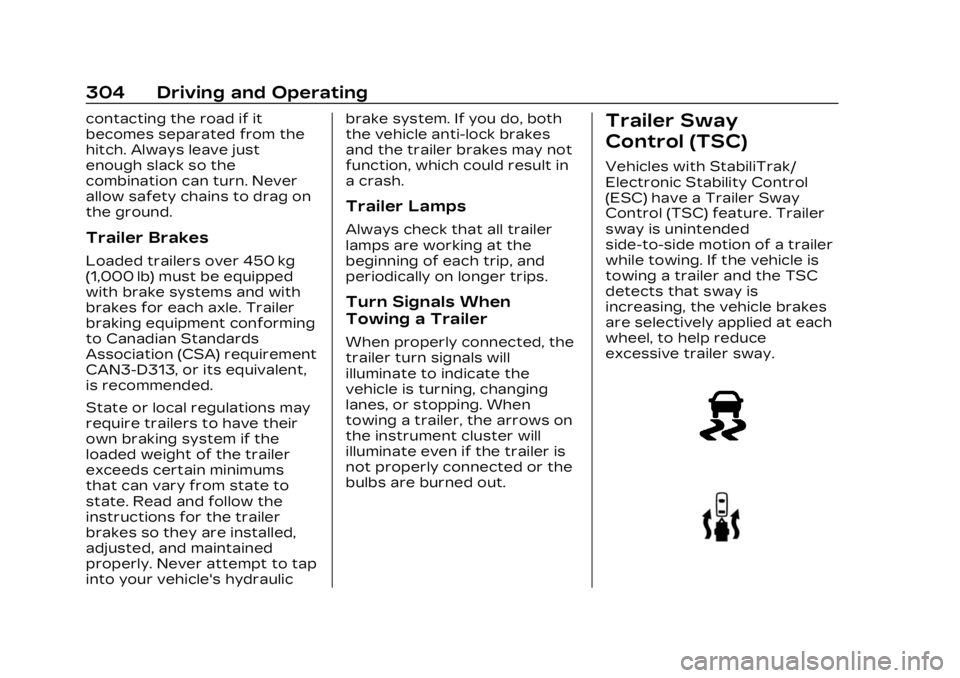
Cadillac Lyriq Owner Manual (GMNA-Localizing-U.S./Canada-15644413) -
2023 - CRC - 2/23/22
304 Driving and Operating
contacting the road if it
becomes separated from the
hitch. Always leave just
enough slack so the
combination can turn. Never
allow safety chains to drag on
the ground.
Trailer Brakes
Loaded trailers over 450 kg
(1,000 lb) must be equipped
with brake systems and with
brakes for each axle. Trailer
braking equipment conforming
to Canadian Standards
Association (CSA) requirement
CAN3-D313, or its equivalent,
is recommended.
State or local regulations may
require trailers to have their
own braking system if the
loaded weight of the trailer
exceeds certain minimums
that can vary from state to
state. Read and follow the
instructions for the trailer
brakes so they are installed,
adjusted, and maintained
properly. Never attempt to tap
into your vehicle's hydraulicbrake system. If you do, both
the vehicle anti-lock brakes
and the trailer brakes may not
function, which could result in
a crash.
Trailer Lamps
Always check that all trailer
lamps are working at the
beginning of each trip, and
periodically on longer trips.
Turn Signals When
Towing a Trailer
When properly connected, the
trailer turn signals will
illuminate to indicate the
vehicle is turning, changing
lanes, or stopping. When
towing a trailer, the arrows on
the instrument cluster will
illuminate even if the trailer is
not properly connected or the
bulbs are burned out.
Trailer Sway
Control (TSC)
Vehicles with StabiliTrak/
Electronic Stability Control
(ESC) have a Trailer Sway
Control (TSC) feature. Trailer
sway is unintended
side-to-side motion of a trailer
while towing. If the vehicle is
towing a trailer and the TSC
detects that sway is
increasing, the vehicle brakes
are selectively applied at each
wheel, to help reduce
excessive trailer sway.
Page 306 of 424
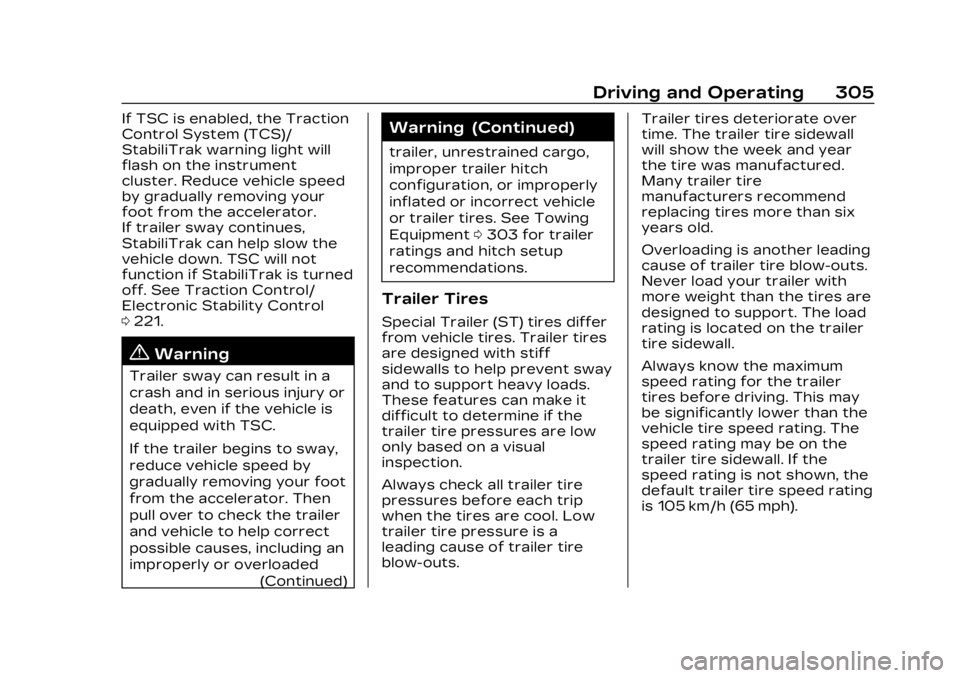
Cadillac Lyriq Owner Manual (GMNA-Localizing-U.S./Canada-15644413) -
2023 - CRC - 2/23/22
Driving and Operating 305
If TSC is enabled, the Traction
Control System (TCS)/
StabiliTrak warning light will
flash on the instrument
cluster. Reduce vehicle speed
by gradually removing your
foot from the accelerator.
If trailer sway continues,
StabiliTrak can help slow the
vehicle down. TSC will not
function if StabiliTrak is turned
off. See Traction Control/
Electronic Stability Control
0221.
{Warning
Trailer sway can result in a
crash and in serious injury or
death, even if the vehicle is
equipped with TSC.
If the trailer begins to sway,
reduce vehicle speed by
gradually removing your foot
from the accelerator. Then
pull over to check the trailer
and vehicle to help correct
possible causes, including an
improperly or overloaded
(Continued)
Warning (Continued)
trailer, unrestrained cargo,
improper trailer hitch
configuration, or improperly
inflated or incorrect vehicle
or trailer tires. See Towing
Equipment0303 for trailer
ratings and hitch setup
recommendations.
Trailer Tires
Special Trailer (ST) tires differ
from vehicle tires. Trailer tires
are designed with stiff
sidewalls to help prevent sway
and to support heavy loads.
These features can make it
difficult to determine if the
trailer tire pressures are low
only based on a visual
inspection.
Always check all trailer tire
pressures before each trip
when the tires are cool. Low
trailer tire pressure is a
leading cause of trailer tire
blow-outs. Trailer tires deteriorate over
time. The trailer tire sidewall
will show the week and year
the tire was manufactured.
Many trailer tire
manufacturers recommend
replacing tires more than six
years old.
Overloading is another leading
cause of trailer tire blow-outs.
Never load your trailer with
more weight than the tires are
designed to support. The load
rating is located on the trailer
tire sidewall.
Always know the maximum
speed rating for the trailer
tires before driving. This may
be significantly lower than the
vehicle tire speed rating. The
speed rating may be on the
trailer tire sidewall. If the
speed rating is not shown, the
default trailer tire speed rating
is 105 km/h (65 mph).
Page 307 of 424
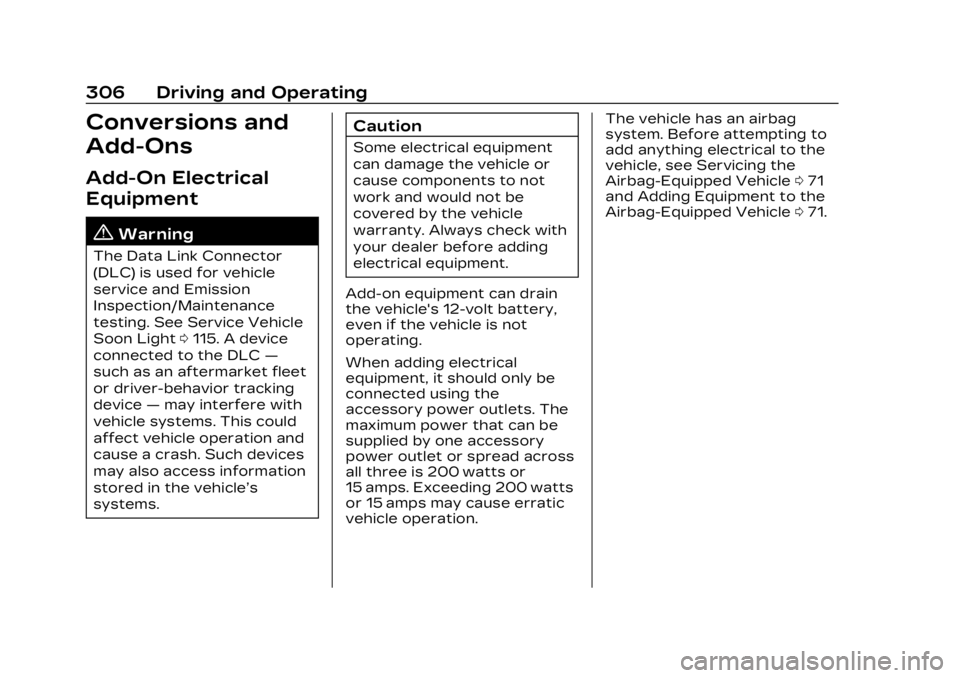
Cadillac Lyriq Owner Manual (GMNA-Localizing-U.S./Canada-15644413) -
2023 - CRC - 2/23/22
306 Driving and Operating
Conversions and
Add-Ons
Add-On Electrical
Equipment
{Warning
The Data Link Connector
(DLC) is used for vehicle
service and Emission
Inspection/Maintenance
testing. See Service Vehicle
Soon Light0115. A device
connected to the DLC —
such as an aftermarket fleet
or driver-behavior tracking
device —may interfere with
vehicle systems. This could
affect vehicle operation and
cause a crash. Such devices
may also access information
stored in the vehicle’s
systems.
Caution
Some electrical equipment
can damage the vehicle or
cause components to not
work and would not be
covered by the vehicle
warranty. Always check with
your dealer before adding
electrical equipment.
Add-on equipment can drain
the vehicle's 12-volt battery,
even if the vehicle is not
operating.
When adding electrical
equipment, it should only be
connected using the
accessory power outlets. The
maximum power that can be
supplied by one accessory
power outlet or spread across
all three is 200 watts or
15 amps. Exceeding 200 watts
or 15 amps may cause erratic
vehicle operation. The vehicle has an airbag
system. Before attempting to
add anything electrical to the
vehicle, see Servicing the
Airbag-Equipped Vehicle
071
and Adding Equipment to the
Airbag-Equipped Vehicle 071.
Page 308 of 424
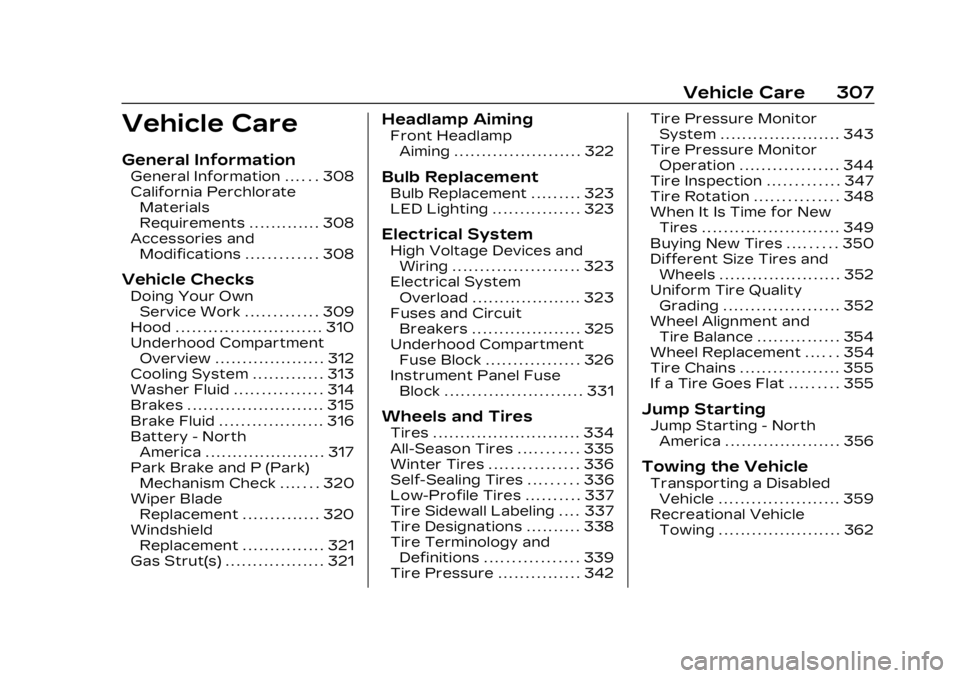
Cadillac Lyriq Owner Manual (GMNA-Localizing-U.S./Canada-15644413) -
2023 - CRC - 2/23/22
Vehicle Care 307
Vehicle Care
General Information
General Information . . . . . . 308
California PerchlorateMaterials
Requirements . . . . . . . . . . . . . 308
Accessories and Modifications . . . . . . . . . . . . . 308
Vehicle Checks
Doing Your OwnService Work . . . . . . . . . . . . . 309
Hood . . . . . . . . . . . . . . . . . . . . . . . . . . . 310
Underhood Compartment Overview . . . . . . . . . . . . . . . . . . . . 312
Cooling System . . . . . . . . . . . . . 313
Washer Fluid . . . . . . . . . . . . . . . . 314
Brakes . . . . . . . . . . . . . . . . . . . . . . . . . 315
Brake Fluid . . . . . . . . . . . . . . . . . . . 316
Battery - North America . . . . . . . . . . . . . . . . . . . . . . 317
Park Brake and P (Park) Mechanism Check . . . . . . . 320
Wiper Blade Replacement . . . . . . . . . . . . . . 320
Windshield Replacement . . . . . . . . . . . . . . . 321
Gas Strut(s) . . . . . . . . . . . . . . . . . . 321
Headlamp Aiming
Front Headlamp Aiming . . . . . . . . . . . . . . . . . . . . . . . 322
Bulb Replacement
Bulb Replacement . . . . . . . . . 323
LED Lighting . . . . . . . . . . . . . . . . 323
Electrical System
High Voltage Devices andWiring . . . . . . . . . . . . . . . . . . . . . . . 323
Electrical System Overload . . . . . . . . . . . . . . . . . . . . 323
Fuses and Circuit Breakers . . . . . . . . . . . . . . . . . . . . 325
Underhood Compartment Fuse Block . . . . . . . . . . . . . . . . . 326
Instrument Panel Fuse Block . . . . . . . . . . . . . . . . . . . . . . . . . 331
Wheels and Tires
Tires . . . . . . . . . . . . . . . . . . . . . . . . . . . 334
All-Season Tires . . . . . . . . . . . 335
Winter Tires . . . . . . . . . . . . . . . . 336
Self-Sealing Tires . . . . . . . . . 336
Low-Profile Tires . . . . . . . . . . 337
Tire Sidewall Labeling . . . . 337
Tire Designations . . . . . . . . . . 338
Tire Terminology andDefinitions . . . . . . . . . . . . . . . . . 339
Tire Pressure . . . . . . . . . . . . . . . 342 Tire Pressure Monitor
System . . . . . . . . . . . . . . . . . . . . . . 343
Tire Pressure Monitor Operation . . . . . . . . . . . . . . . . . . 344
Tire Inspection . . . . . . . . . . . . . 347
Tire Rotation . . . . . . . . . . . . . . . 348
When It Is Time for New
Tires . . . . . . . . . . . . . . . . . . . . . . . . . 349
Buying New Tires . . . . . . . . . 350
Different Size Tires and Wheels . . . . . . . . . . . . . . . . . . . . . . 352
Uniform Tire Quality Grading . . . . . . . . . . . . . . . . . . . . . 352
Wheel Alignment and Tire Balance . . . . . . . . . . . . . . . 354
Wheel Replacement . . . . . . 354
Tire Chains . . . . . . . . . . . . . . . . . . 355
If a Tire Goes Flat . . . . . . . . . 355
Jump Starting
Jump Starting - North America . . . . . . . . . . . . . . . . . . . . . 356
Towing the Vehicle
Transporting a DisabledVehicle . . . . . . . . . . . . . . . . . . . . . . 359
Recreational Vehicle Towing . . . . . . . . . . . . . . . . . . . . . . 362
Page 309 of 424
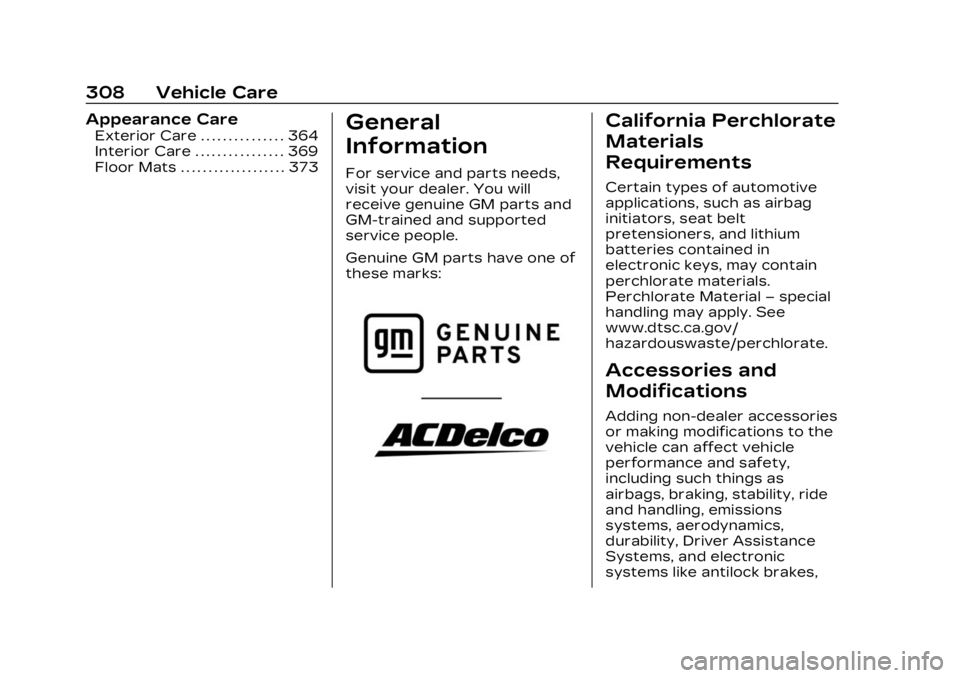
Cadillac Lyriq Owner Manual (GMNA-Localizing-U.S./Canada-15644413) -
2023 - CRC - 2/23/22
308 Vehicle Care
Appearance Care
Exterior Care . . . . . . . . . . . . . . . 364
Interior Care . . . . . . . . . . . . . . . . 369
Floor Mats . . . . . . . . . . . . . . . . . . . 373General
Information
For service and parts needs,
visit your dealer. You will
receive genuine GM parts and
GM-trained and supported
service people.
Genuine GM parts have one of
these marks:
California Perchlorate
Materials
Requirements
Certain types of automotive
applications, such as airbag
initiators, seat belt
pretensioners, and lithium
batteries contained in
electronic keys, may contain
perchlorate materials.
Perchlorate Material–special
handling may apply. See
www.dtsc.ca.gov/
hazardouswaste/perchlorate.
Accessories and
Modifications
Adding non-dealer accessories
or making modifications to the
vehicle can affect vehicle
performance and safety,
including such things as
airbags, braking, stability, ride
and handling, emissions
systems, aerodynamics,
durability, Driver Assistance
Systems, and electronic
systems like antilock brakes,
Page 310 of 424
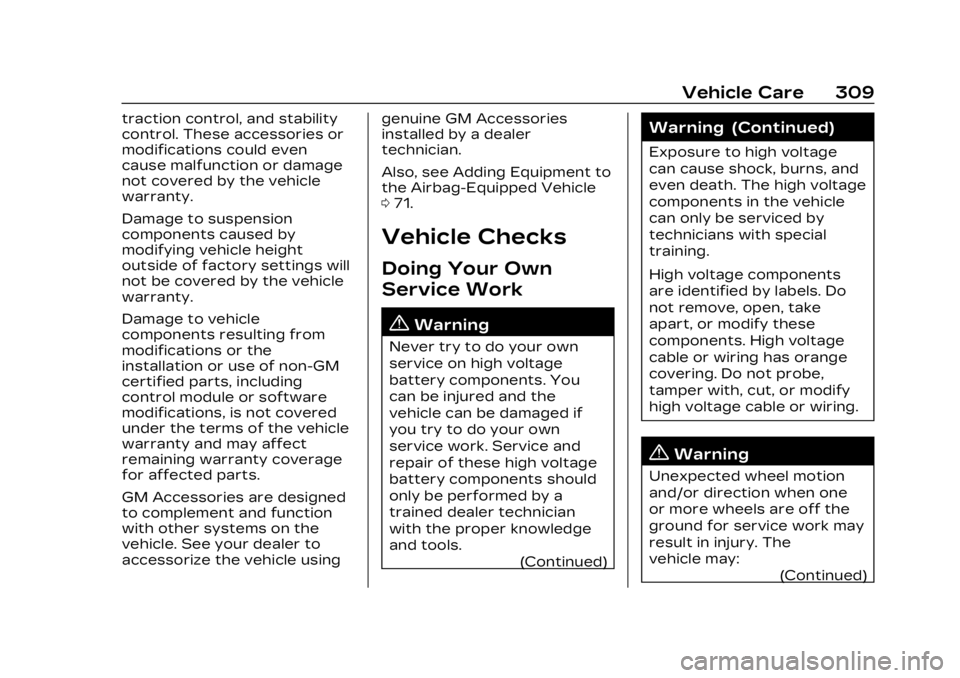
Cadillac Lyriq Owner Manual (GMNA-Localizing-U.S./Canada-15644413) -
2023 - CRC - 2/23/22
Vehicle Care 309
traction control, and stability
control. These accessories or
modifications could even
cause malfunction or damage
not covered by the vehicle
warranty.
Damage to suspension
components caused by
modifying vehicle height
outside of factory settings will
not be covered by the vehicle
warranty.
Damage to vehicle
components resulting from
modifications or the
installation or use of non-GM
certified parts, including
control module or software
modifications, is not covered
under the terms of the vehicle
warranty and may affect
remaining warranty coverage
for affected parts.
GM Accessories are designed
to complement and function
with other systems on the
vehicle. See your dealer to
accessorize the vehicle usinggenuine GM Accessories
installed by a dealer
technician.
Also, see Adding Equipment to
the Airbag-Equipped Vehicle
0
71.
Vehicle Checks
Doing Your Own
Service Work
{Warning
Never try to do your own
service on high voltage
battery components. You
can be injured and the
vehicle can be damaged if
you try to do your own
service work. Service and
repair of these high voltage
battery components should
only be performed by a
trained dealer technician
with the proper knowledge
and tools.
(Continued)
Warning (Continued)
Exposure to high voltage
can cause shock, burns, and
even death. The high voltage
components in the vehicle
can only be serviced by
technicians with special
training.
High voltage components
are identified by labels. Do
not remove, open, take
apart, or modify these
components. High voltage
cable or wiring has orange
covering. Do not probe,
tamper with, cut, or modify
high voltage cable or wiring.
{Warning
Unexpected wheel motion
and/or direction when one
or more wheels are off the
ground for service work may
result in injury. The
vehicle may:(Continued)